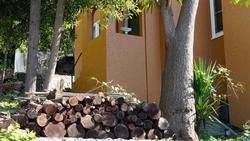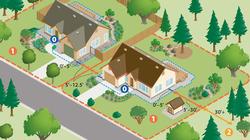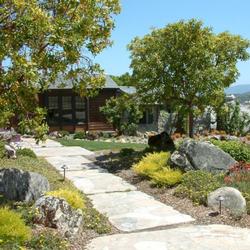Make your home and garden more fire resilient with these easy and effective steps
-
Julie McMillan
-
California wildfires are becoming more frequent, intense and destructive. While we used to prepare for “fire season” each fall, now we need to work year-round to make our homes and gardens more fire resilient. Here are some easy and effective steps to take.
 Relocate wood piles and other flammable items at least 30’ from your home. Photo: Fay Mark
Relocate wood piles and other flammable items at least 30’ from your home. Photo: Fay MarkThe most significant cause of home ignition are embers, small pieces of burning material that can travel by the wind more than a mile from a wildfire. Embers can create spot fires when they land on combustible materials such as dry leaves in roof gutters, near basement and attic vents, or in your garden.
To reduce potential ignition from embers, create areas of defensible space. These eliminate pathways for a wildfire to burn directly to your home and establish buffers between your home, garden and the wildland. Defensible space also makes room for firefighters to extinguish embers and spot fires and establishes safe evacuation routes. To create defensible space, focus on three zones. Start with your house and work your way out.
“Zone Zero” is the five foot area immediately surrounding your home and other structures. Eliminate all combustible materials and vegetation in Zone Zero to reduce the potential for direct flame contact from ember ignitions:
 To create defensible space, focus on the 3 zones around your home: Zone 0: first 5'; Zone 1: 5-30’; Zone 2: more than 30’. Photo: UCANR
To create defensible space, focus on the 3 zones around your home: Zone 0: first 5'; Zone 1: 5-30’; Zone 2: more than 30’. Photo: UCANR- Clean up leaves and needles from roofs and gutters
- Remove tree limbs overhanging the roof
- Remove organic materials, including accumulated leaves, plants, mulch, planter boxes, woody vegetation and climbing plants
- Replace wood fences adjacent to structures with metal
- Replace wood gates, trellises, arbors and lattice with metal
- Move propane tanks and wood piles 30’ away or store in noncombustible containers
- Replace natural fiber door mats
- Store plastic garbage and recycling containers in noncombustible enclosures
Zone Zero is a perfect location for walkways or hardscaping with pavers, rock mulch, or pea gravel. It may not be possible to remove all vegetation; consider sparsely planted, widely separated, low growing, nonwoody plants without organic mulch.“Zone One” is five to 30’ from your home. Break up paths between garden beds, shrubs, and trees with hardscape, gravel or soil so that if a wildfire enters this area, vegetation will not burn up to your house or into tree crowns:
 Create areas of defensible space to break up fire’s path to your home.Photo: FireSafe Marin
Create areas of defensible space to break up fire’s path to your home.Photo: FireSafe Marin- Use hardscape or gravel to separate shrubby bushes, perennials, and groundcovers
- Remove all dead debris
- Limb up trees by removing branches six feet from the ground to reduce ladder fuels
- Space trees so that crowns are at least 10’-15’ apart at maturity
- Avoid planting trees in rows or hedges
- Prune plants regularly by removing dead or dying plant material
- Avoid massing shrubs at tree bases
- Add organic amendments to increase soil’s moisture capacity
- Avoid gorilla hair mulch, which is highly flammable; use large wood chips instead, but as they can also burn, apply sparingly and not continuously
While all plants burn, some may burn faster than others. As you consider adding plants in Zone One, chose those that are water wise and ecologically sound, well maintained and in good health. Good options include California natives and pollinator-friendly or drought-tolerant plants.Finally, “Zone Two” is everything beyond 30’ from your home. Lower the flame heights and slow the spread of an approaching wildfire:
- Reduce the density of trees, shrubs, and woody plants
- Trim tree branches at least 10’ away from other trees
- Limb up lower tree branches at least 10’
- Eliminate dead or dying trees and vegetation
- Remove fallen leaves, twigs, bark, and small branches
Creating defensible space becomes even more critical if you live on a slope near a canyon or ridge. Fire travels faster uphill by preheating vegetation from below, making it easier to ignite. If you have space, consider constructing a stone or concrete wall between your house and fire’s most likely path. Vegetation on slopes should be low in height and volume.For more resources, please visit https://marinmg.ucanr.edu/BASICS/FIRESMARTLANDSCAPING/MMG and https://firesafemarin.org/create-a-fire-smart-yard/.



